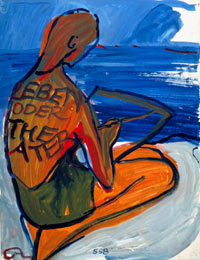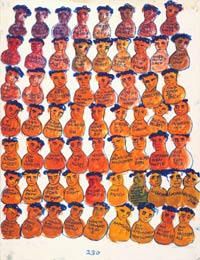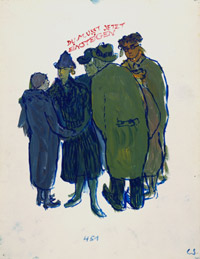 |
|
 |
|
 |
|
 |
|
 |
|
 |
|
| Charlotte
Salomon Life? Or Theater? March 16 – June 3, 2007 |
|||||||
|
|||||||
|
Opening Thursday, March 15, 2007, 7 p.m. Opening: Dr. Franz Fischler, former EU commissioner Welcome: Dr. Esther Fritsch, president of the Jewish Community for Tyrol and Vorarlberg Introduction: Dr. Brigitte Reinhardt, director of the Ulmer Museum, Ulm Drs. Edward van Voolen, curator of the exhibition, Joods Historisch Museum, Amsterdam |
||||||
| Charlotte Salomon
(1917-1943) has created a unique piece with her series of paintings
titled Life? Or Theater?.
On 1,325 sheets she documented her life and that of her family. Salomon
called it a “Singespiel” or lyrical drama, a
dramaturgical combination of painting and text intended to be set to
music. Charlotte Salomon. Life?
Or Theater?, the travelling exhibition put together by the
Joods Historisch Museum in Amsterdam and to be shown at the Galerie im
Taxispalais, comprises a selection of some 280 gouaches with
accompanying text panels. Charlotte Salomon created her oevre within a period of two years, between 1940 and 1942, in exile in Villefranche-sur-Mer, France. She, a Jewess, had fled from Berlin, following her grandparents to this town. In 1943, shortly after she had married Alexander Nagler, an Austrian Jewish refugee, she was betrayed and arrested by the Germans. That same year she was killed in Auschwitz, and soon after her husband succumbed to the same fate. Her oeuvre was hidden in France. Albert and Paula Salomon, her father and her stepmother, had survived the Shoah in the Netherlands and travelled to France in 1947. Ottilie Moore, the American, who had provided Charlotte and her grandparents refuge, handed them the works. In 1971 Paula and Albert Salomon donated the entire oeuvre to the Amsterdam Joods Historisch Museum. Charlotte Salomon lets her story begin before her birth and tells about her life in Berlin where she grew up in a well-to-do family with strong interest in the arts. She describes her mother who committed suicide while she was still a child, and her father, a professor for medicine who later married the well-known singer Paula Lindberg. From 1935 to 1937 Charlotte Salomon studied art. She tells about the young girl’s passions, which were overshadowed by the tragic events in her family. She also gives an account of the political events that influenced here life: The Nazi seizure of power in 1933, the increasing anti-Semitic repression – her father was detained for some time at the Sachsenhausen concentration camp – and finally her flight to her grandparents in Southern France. Salomon gave Life? Or Theater? the subtitle “Tricolor Singespiel”, because it contains both spoken dialogues as well as music and because the color mixes and shades are painted in only three colors – red, blue and yellow. Life? Or Theater? consists of a prelude, a main part and an afterword. In her narrative, Salomon makes use of filmic means such as flashback and montage, seriality, change of perspective and close up. Similar to a comic, she adds texts to the scenes either as text panels placed below the image or she integrates text in the image. Life? Or Theater? is a fictionalized autobiography featuring more than twenty characters with invented names. “They are protagonists of a dramatized life in which reality and invention are deliberately merged. Charlotte Salomon has withdrawn to the role of the ‘author’. An author who functions as a narrator, sometimes with detached descriptions, and often with ironic comments.” (Astrid Schmetterling) The selection of musical pieces can also be structurally compared with film. Salomon alternates between serious music such as songs and opera arias and popular music such as traditional songs and hits that accompany or complement a given scene. |
|||||||
| Conference Friday, March 16, 2007, 2 – 6 p.m. Moderator Prof. Dr. Daniela Hammer-Tugendhat, art historian, University of Applied Arts Vienna Speakers Prof. Dr. Ernst van Alphen, literary scholar, University of Leiden Pre- and Post-Holocaust Perspectives on Charlotte Salomon’s Life? Or Theater? (English) Dr. Annegret Friedrich, art historian, University of Gießen Cinema, Comic, Caricature: On the modernity of Charlotte Salomon (German) Hannes Sulzenbacher, curator, Jewish Museum Hohenems Perspectives of Jewish Museums in the Present. On the Perception and Narration of Jewish History (German) Drs. Edward van Voolen, curator, Joods Historisch Museum, Amsterdam Departure for Exile: Charlotte Salomon. Introductory Remarks (German) |
|||||||
| Film series on Charlotte Salomon Charlotte Thursday, April 19, 2007, 6:30 p.m. 1980, 93 min. Director: Frans Weisz Cast: Birgit Doll, Derek Jacobi, Elisabeth Trissenaar, Brigitte Horney, et al. The film is based on the life story of Charlotte Salomon who fled from Berlin and traveled to her grandparents in Southern France in 1939. As a response to her desperation Charlotte began to paint. The director Frans Weisz will be present. Paul Paulinka Thursday, April 26, 2007, 6:30 p.m. 1996, 63 min. Script and direction: Christine Fischer-Defoy, Caroline Goldie, Daniela Schmidt Christine Fischer-Defoy, Caroline Goldie and Daniela Schmidt visited the 96-year-old Paula Salomon-Lindberg (1897-2000), Charlotte Salomon’s step-mother, in Amsterdam. The film traces the life story of this exceptional woman, a celebrated singer. Die Liebe, mein Schatz, ist bodenlos (Love My Darling Is Bottomless) Thursday, May 3, 2007, 6:30 p.m. 1998, 68 min. Director: Sabine Willmann Cast: Amalie Bizer, Michael Holz, Daniela Ziegler, et al. The film stages Charlotte Salomon’s series of paintings Life? Or Theater? as a documentary feature film. The central focus is her first great love, her singing instructor Alfred Wolfsohn, figuering as Amadeus Daberlohn in the play. The director Sabine Willmann will be present. |
|||||||
| In
collaboration with the Joods Historisch Museum, Amsterdam, Curator: Edward van Voolen Catalogue Charlotte Salomon Leben? Oder Theater? Prestel Verlag, Munich 2004, 432 pp., 835 color ill., € 29.90 Acknowledgements Brigitte Reinhardt, Ulmer Museum, Ulm Federal Foreign Office, Germany Royal Netherlands Embassy, Vienna |
|||||||
|
|||||||





